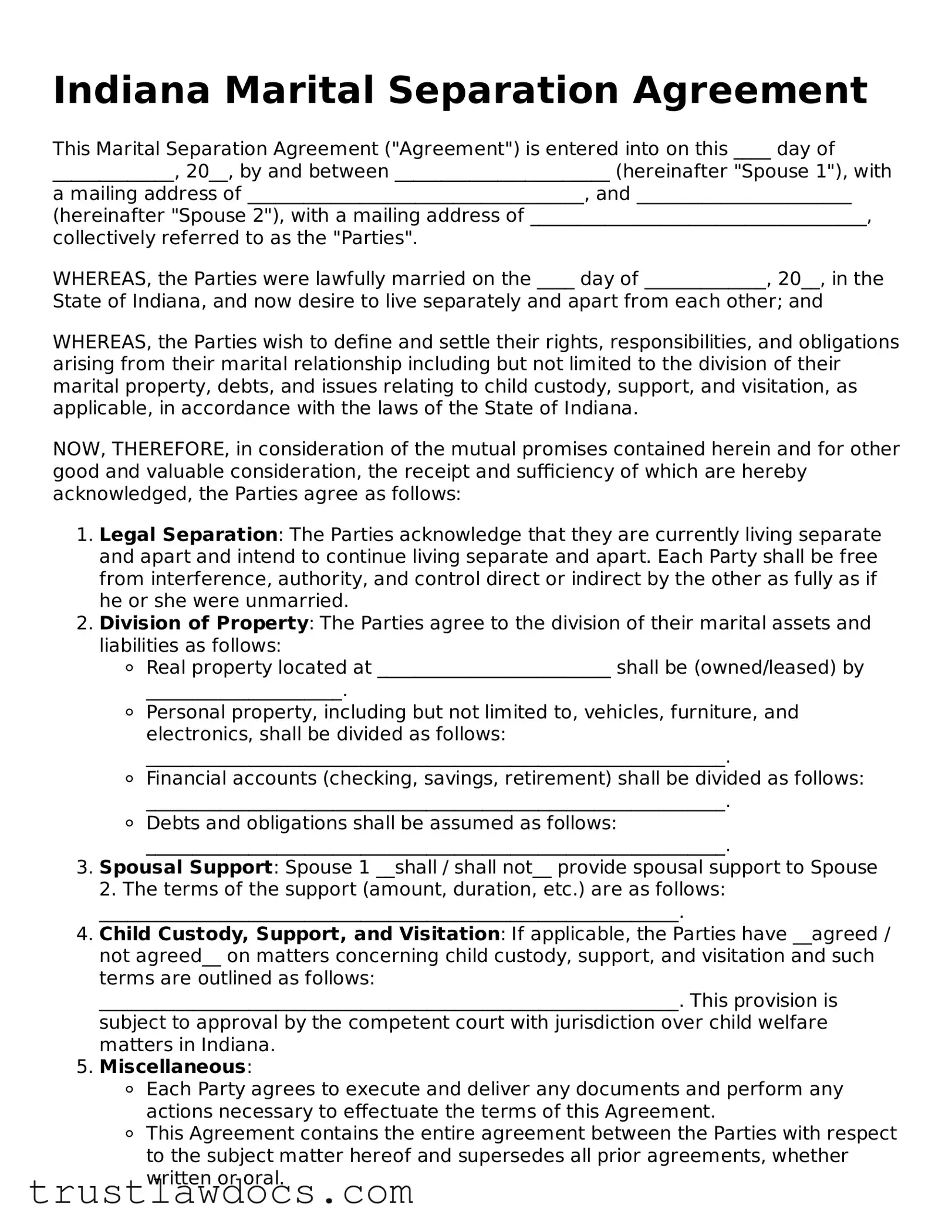Indiana Marital Separation Agreement
This Marital Separation Agreement ("Agreement") is entered into on this ____ day of _____________, 20__, by and between _______________________ (hereinafter "Spouse 1"), with a mailing address of ____________________________________, and _______________________ (hereinafter "Spouse 2"), with a mailing address of ____________________________________, collectively referred to as the "Parties".
WHEREAS, the Parties were lawfully married on the ____ day of _____________, 20__, in the State of Indiana, and now desire to live separately and apart from each other; and
WHEREAS, the Parties wish to define and settle their rights, responsibilities, and obligations arising from their marital relationship including but not limited to the division of their marital property, debts, and issues relating to child custody, support, and visitation, as applicable, in accordance with the laws of the State of Indiana.
NOW, THEREFORE, in consideration of the mutual promises contained herein and for other good and valuable consideration, the receipt and sufficiency of which are hereby acknowledged, the Parties agree as follows:
- Legal Separation: The Parties acknowledge that they are currently living separate and apart and intend to continue living separate and apart. Each Party shall be free from interference, authority, and control direct or indirect by the other as fully as if he or she were unmarried.
- Division of Property: The Parties agree to the division of their marital assets and liabilities as follows:
- Real property located at _________________________ shall be (owned/leased) by _____________________.
- Personal property, including but not limited to, vehicles, furniture, and electronics, shall be divided as follows: ______________________________________________________________.
- Financial accounts (checking, savings, retirement) shall be divided as follows: ______________________________________________________________.
- Debts and obligations shall be assumed as follows: ______________________________________________________________.
- Spousal Support: Spouse 1 __shall / shall not__ provide spousal support to Spouse 2. The terms of the support (amount, duration, etc.) are as follows: ______________________________________________________________.
- Child Custody, Support, and Visitation: If applicable, the Parties have __agreed / not agreed__ on matters concerning child custody, support, and visitation and such terms are outlined as follows: ______________________________________________________________. This provision is subject to approval by the competent court with jurisdiction over child welfare matters in Indiana.
- Miscellaneous:
- Each Party agrees to execute and deliver any documents and perform any actions necessary to effectuate the terms of this Agreement.
- This Agreement contains the entire agreement between the Parties with respect to the subject matter hereof and supersedes all prior agreements, whether written or oral.
- This Agreement may only be amended or modified by a written document executed by both Parties.
- This Agreement shall be governed by and construed in accordance with the laws of the State of Indiana, without regard to conflicts of law principles.
IN WITNESS WHEREOF, the Parties have executed this Agreement as of the date first above written.
Spouse 1 Signature: _____________________________________ Date: _____________
Spouse 2 Signature: _____________________________________ Date: _____________
Notary Public:
State of Indiana )
_________________) ss:
County of ________)
Subscribed and sworn before me this ____ day of ______________, 20__.
Notary Public Signature: __________________________________
My Commission Expires: ___________________
